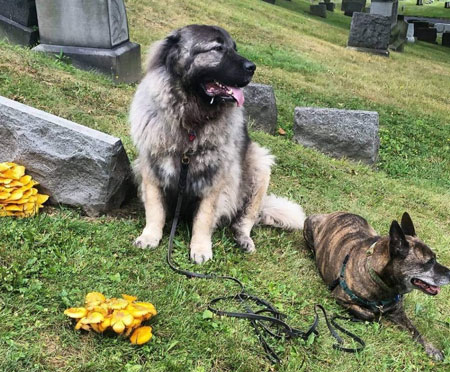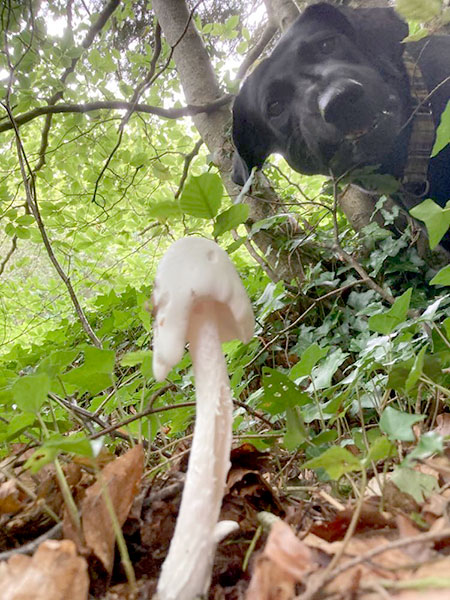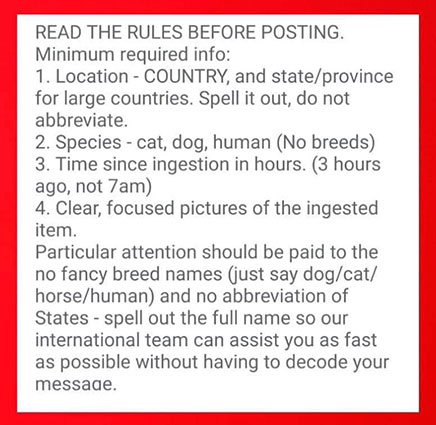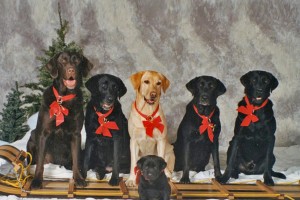What’s In Your Mouth?: Why Teaching an Auto-Leave-It Can Save Your Dog’s Life
I cannot even adequately count how many clients I have had who have created resource guarding with their puppies and/or adult dogs by screaming some version of the above, while actively chasing said dog to get whatever item they may have grabbed. Thus begins a protocol where the dog’s own human makes forbidden items far more attractive than they would be without all that attention shown to such. We humans sure do know how to muck things up, don’t we? How do we stop? Well, read on.
I have a personal theory that adult dogs who haven’t already had negative attention paid to such would know what is and isn’t dangerous to them within the world of plants and mushrooms. After all, free ranging dogs can’t take themselves to the doggy ER and they seem to do okay with this task. Same with feral cats actually, but since I don’t personally deal with cat behavior, we shall stick with dogs here. Read below for some information on free ranging dogs.
Free Ranging Dogs and Foraging
It seems that it’s us humans who create dangerous fixations on all of the things that we deem restrictive for dogs. I have personally always let my adult dogs graze on grasses and plants that they seem attracted to. They always ended up knowing what was and wasn’t okay. I googled before they snacked, when interest was shown and in addition to long/fresh spring grasses, they most enjoyed Goldenrod prior to and up to blooming, as well as broadleaf plantain. Google tells me that they aid in digestion. I considered this their daily salad intake and planned time for grazing during pretty much every walk. Contrary to popular belief, they did not use this time or these plants as a means to throw up. When that was the desired outcome, they seemed to gravitate to coarser grades of grass, and it was a thankfully rare occurrence. More on that here.
So how exactly do we humans create their fixation on eating things that aren’t good for them? The same way that we humans create resource guarding in puppies who don’t already have that tendency in their DNA. We behave in a dramatic, combative, and eager to seize manner towards their interest in things that they should not have. We literally *create* an unhealthy interest in such, rather like when you dramatically call something off limits for your human children, therefore make it far more attractive than it ever would have been without that label. Running after a dog/puppy and screaming some version of “what’s in your mouth??!!” while looking and sounding like the panicked human that we may be at that moment isn’t the deterrent that you think it should be. It really is rather like telling your teenager that they cannot hang out with so and so. So and so then becomes the most attractive friend ever. Let the surreptitious games begin! This then happens more and more frequently, as it’s wont to be with puppies especially. The puppy/dog in question then begins to look for items to place into their mouth in order to gain your attention to such. Negative attention is still attention and is super fun for dogs to initiate.
This game then becomes far more dangerous than it needs to be in soooooo many contexts. Focusing on dramatic behavior when a dog shows an interest in things like wild mushrooms, your garden, houseplants, household items that can cause harm, etc. is not how you want to address this. The best option to start with is to be the most interesting human you can be in that context and run AWAY from whatever the puppy/dog shows interest in and heartily reinforce and reward for coming WITH/TO you. Act like you are having the VERY BEST DOG PARTY EVER and get that dog/puppy moving towards you instead of telling them what not to do. Active supervision is also your friend here. If you are distracted and wait until after the fact to address this, then you take the chance that the dog eats the item in question. A hefty vet bill can soon follow. Lives can even be lost. Acting when there is interest but before it ends up in their mouth is the goal here. It really doesn’t take long to teach alternate interest.
In conjunction with an auto name response recall, I also teach handing over an item in a non-combative manner. I call mine Can I Have That? The short version is “come to me and I will pay you handsomely for what you have”. I won’t include that instructional here as it will create something far longer than many people will read and that is contrary to my goal. Next time. Stay tuned.
First and foremost, I teach what I call a Wordless Leave It, but many trainers also call an auto leave it. This means teaching a dog that they get handsomely rewarded for ignoring things that might interest them, that they have not directly been given by their human. I consider this behavior a lifesaver. Here is the short version below. Caveat, with most dogs you can actually start at the 5th step with using a surface versus using both hands :
- Take a really high value treat in one hand and show it to your dog. Have more of the same treats in your other hand ready to offer as a reward. Put that hand behind your back.
- If your dog licks and paws at your offered hand to try and get the treat, don’t say anything. Simply wait for him to stop, however briefly that may be. It may take a bit and you may have to wear thin gloves to prevent your hand from getting scratched if your dog is super intent on getting the treat RIGHT NOW! Do not say anything to try to get your dog to stop, just be patient. The second your dog stops trying to get the treat or looks or backs away from the treat, even for a second, say “yes!” and offer a treat from your hidden hand. Be sure to be very enthusiastic in rewarding your dog verbally for a job well done. The timing of the marker word is important. That comes first, at the very moment that your dog makes that good decision. The treat comes after the verbal marker.
- Different dogs have different ways of backing off. Some will simply stop trying to get the item. Some will look up at you. Some will back up, knowing that they need more space to not grab the thing and some will back up their posture, some will offer increasing levels of self control starting with a sit, etc. Know your dog please, so that you can properly shape this.
- Switch hands each time you repeat this procedure until your dog starts looking at the hidden hand when you offer your hand. When this happens, you can now wait until your dog looks away from either or looks at you. Mark that and then reward.
- Next you will place the treat inside your closed hand on a raised surface or some sort, eventually transitioning to the floor. How fast this moves forward depends on the individual dog. Repeat the already described protocol, rewarding appropriately. The floor placement will make this procedure hardest at first, regardless of how well your dog just did on the previous step. When your dog totally gets each step, it’s time to move on. It may take several sessions and that is okay.
- Moving forward, you will partially uncover the treat on the floor, being very careful that you can cover it before your dog can grasp it if he moves to take it. Remember, you will not be verbally correcting your dog at all. Your role is to verbally mark and then food reward the behavior you want and only that.
- Next you will uncover the treat even more, again taking care to be faster than your dog should you need to be. It is of vital importance that you move at the speed that your dog needs, in order to make this a solid behavior. This is not a competition. Your goal is to train this into a solidly understood behavior.
- Every success with several repetitions within an individual training session is a cue to move forward to the next step but do so only briefly. End each session on a positive successful note.
- It is important to practice this behavior in any room that it would be applicable in, as well as outdoors if appropriate.
- Your goal is to progress to a point where you can toss something on the floor and have it ignored, though I would suggest that when you begin to practice with this step, you leash your dog. You will also play goalie with this type of practice by placing your body between the treat and the dog, as needed. Never use the leash to separate the two, just body language. This will turn into a situational cue. Your guests would not know what to say to keep your dog from going after something that they dropped on the floor, but they will automatically reach for it, cueing the dog that it is not theirs. You will, of course, again mark and reward your dog for the exact moment that he chooses not to go after the treat. (a hint for this particular step: use a higher value reward in your hand than the one that you are tossing)
You can move forward with using any item that may be of interest to your dog/puppy as the teaser item.
THE IMPORTANT PART OF TEACHING THE ABOVE IS THAT THE DOG NEVER GETS REWARDED WITH/FROM WHAT YOU WANT THEM TO IGNORE. NEVER. The reward always comes from elsewhere but is equal to or of higher value than whatever they are being asked to ignore. Otherwise, what is the point???
I have two stories of my own to share that can show how important working on this type of behavior can be. Many years ago, when Merlin, Kera, Siri, and Trent were all alive and young, I shared a Thanksgiving meal with my mother at my house. Prior to taking her home, I deconstructed the turkey and placed all of the discards in a garbage bag, which I then sealed and planned to take out to the garbage can when I took my mother home. I arrived back home from taking my mother home, a drive of only 5 minutes or so and upon walking back into my house, I discovered that I had left the garbage bag inside of the kitchen. I burst into tears as I could have killed my dogs with this mistake. What were they doing? They were all relaxing quite happily in various spots on the floor in my large kitchen, looking at me like I was crazy. The bag was intact exactly where I left it. The other amazing event that I inadvertently caused was on a road trip many years later, with Kenzo, my Caucasian Ovcharka, and Trent, my Pit Bull mix. We were returning back to Pennsylvania from a road trip to the tip top of Maine’s coast. I stopped at a convenience store in Connecticut to eat lunch. I took my sandwich out of the cooler and laid it on my passenger seat and discovered that I was almost out of bottled water, so I went inside the store to get more, forgetting that the sandwich was on the seat. I came back and found Kenzo’s face still resting on the console in between the front seats, mere inches from the sandwich and the sandwich was untouched. These are only the major ones that I can remember. There are many many tales of minor instances where my dogs simply don’t pay attention to anything, no matter how tempting, that I have not directly given them. This can be your experience too, if you choose to put the work in.
You can do the above with so many things including food that you want to eat on a level that a dog may try and steal it such as on a coffee table, tissues and paper products that puppies inevitably find attractive, things in your yard that you wish to have your dog ignore such as mulch/plants/etc. I have even done this with duck poop along the Ohio River. No, I didn’t touch the poop, I just covered it/body blocked it and rewarded backing off.
Consistency and repetition, along with proper management when training this behavior, will ensure that you actually can look away for a moment and not have your dog ingest something that will cause them to end up in the doggy ER. This is a behavior that can literally save your dog’s life. Please try and spend time training an auto leave it instead of spending time chasing after your dog to get things out of their mouth.
A word on very young puppies, you can definitely start this process at a young age but do keep in mind that puppies are the canine equivalent of an infant/toddler. Everything they can access WILL go into their mouth. You can either act by starting this process off on the right paw by utilizing what I have written here, or you can react after your puppy has eaten something that can harm them. Acting also includes strict management along with active supervision. Simply being in the environment with them is not active supervision. Please understand the difference as it can mean the difference between life and death. If you mess up (and you will in the beginning so don’t beat yourself up, just aim to do better), then keep this group handy.
Poisons Help; Emergency Identification for Mushrooms & Plants
This is a valuable resource that is offered no charge to people for accidental/mistaken ingestion by any species. Please respect the fact that these people offer their time and expertise for free so don’t get me disliked/banned by my referral to the group and you disregarding their rules. Americans in general, are the absolute worst at following the required directions. You can see that for yourself there. Be the American exception if you live in the US please. Don’t be that American that causes an eye roll. It takes less than a minute to follow the rules. You will get props from everyone for doing so. Here’s hoping that you never need that group! Get started with the auto leave it protocol to insure such please. Tell me your stories in the comments if you have some.
Posted in: Projects
Leave a Comment (0) →





